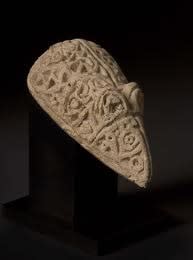Bath Scraper, 9th Century CE - 11th Century CE
fritware
3.4
JB.1017
The bath scraper has a rough base and fits comfortably into the hand, which supports the idea that this and similar objects were used as bath scrapers. They were often...
The bath scraper has a rough base and fits comfortably into the hand, which supports the idea that this and similar objects were used as bath scrapers. They were often produced in large numbers from standard moulds. Examples of moulds for more basic less decorated versions can be seen, for example in the Al- Sabah collection at the Kuwait National Museum. This item is far more intricate and may have been entirely carved or finished by hand giving it greater importance as an artifact.
Many of the standard molded objects have emerged from Afghanistan in recent past years, however, this example is truly noteworthy in its detail which lends credence to its provenance from an important noble household. Mould, buff earthenware, hemispherical for moulding the exterior of a bowl, with engraved designs of two large epigraphic bands running around.
Iran or Central Asia, 9th – 11th century.
Comparative material: there are similar, glazed and unglazed bath scrapers in the Al-Sabah Collection in Kuwait, cf. Watson, 2004, cat.nos.L.30/a-c, inv.nos.LNS577C, LNS848C and LNS531 Prof. Geza Fehervar Prof. Geoffrey Kin
Many of the standard molded objects have emerged from Afghanistan in recent past years, however, this example is truly noteworthy in its detail which lends credence to its provenance from an important noble household. Mould, buff earthenware, hemispherical for moulding the exterior of a bowl, with engraved designs of two large epigraphic bands running around.
Iran or Central Asia, 9th – 11th century.
Comparative material: there are similar, glazed and unglazed bath scrapers in the Al-Sabah Collection in Kuwait, cf. Watson, 2004, cat.nos.L.30/a-c, inv.nos.LNS577C, LNS848C and LNS531 Prof. Geza Fehervar Prof. Geoffrey Kin
